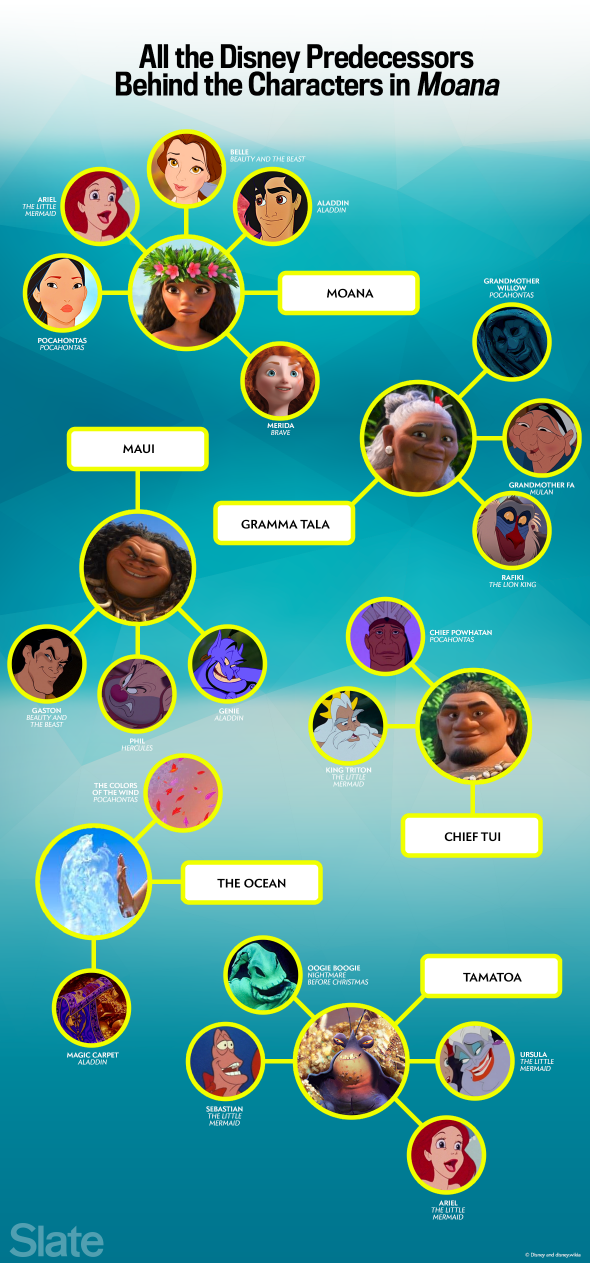You’d be hard-pressed to find a review of Moana that doesn’t point out how it gives off strong nostalgic vibes from Disney’s renaissance era—the late-’80s–mid-’90s period that saw a wave of critical and commercial hits that drew heavily from Broadway musicals. The most obvious throwback within the studio’s latest film is the demigod Maui, voiced by Dwayne Johnson, who feels like Robin Williams’ memorable Genie character refitted for the modern age. They two characters only share an ability to shape-shift but also a very similar send-off in their films’ respective finales—bidding their newly acquired friend and partner in adventure a fond goodbye, then flying away joyously, drawing circles in the sky.
Moana’s characters, as it turns out, share a lot of DNA with their Disney forebears. Even more than Frozen, which took seemingly deliberate cues from its predecessors while updating them for modern sensibilities, this latest film traces shamelessly over the Disney blueprint. (This is not surprising seeing as Moana’s directors, Ron Clements and John Musker, were also responsible for The Little Mermaid and Aladdin.)
So here’s a breakdown of the many ancestors of Moana.
Moana
She may insist on not being called a princess, but she does possess many qualities reminiscent of Disney princesses before her: Like Ariel and Pocahontas, she can’t resist the pull of the unknown and brazenly defies her father’s wishes in order to satisfy her curiosity. Unlike those two characters, her curiosity has nothing to do with a handsome prince or a white English settler but with saving her family and people—which is why she’s also like Belle, who first ventures from her “poor provincial town” to save her father from the Beast. Throw in a dash of Aladdin’s excellent acrobatic skills and the fact that, like Merida (the first Pixar character included in Disney’s princess line), she doesn’t end up with a man at the end, and you’ve got Moana.
Maui
Once again, Maui is basically Genie—the song “You’re Welcome,” with its braggadocio and fast-talking lyrics, is the 21st-century “Friend Like Me.” But his genetics also include a bit of Gaston’s egotism. And like Phil, the retired trainer of the gods who’s disgraced and depressed after a string of failures, Maui is initially reluctant to help his new friend out of both fear and disappointment, having been responsible for bringing about the curse upon Moana’s people.
Gramma Tala
“You may hear a voice inside/ And if the voice starts to whisper/ To follow the farthest star/ Moana, that voice inside is who you are,” she sings in the rousing “Where You Are.” This sounds an awful lot like when Grandmother Willow urges Pocahontas to “Listen with your heart, you will understand/ Let it break upon you like a wave upon the sand”—and they both embody spirits who provide the motivation and guidance the heroes need to pursue their dreams (and defy their fathers). Gramma Tala is also proudly kooky but no less wise—just like Grandmother Fa and Rafiki.

Illustration by Slate. Photos by © Disney and disney.wikia.
Chief Tui
What good is being a princess—er, daughter of a chief and heir to his chiefdom—if you can’t defy your overprotective father? Like King Triton and Chief Powhatan before him, Chief Tui primarily exists to forbid his daughter from being adventurous, all in the name of keeping her safe. Still, Tui should be thankful that the most he has to worry about with Moana is her venturing off beyond the reef and not falling in love with a stranger from another world.
Tamatoa
The closest thing Moana has to a villain, Tamatoa has a luminescent color scheme and penchant for menacing taunts that bear resemblance to the ghastly Oogie Boogie. (No, The Nightmare Before Christmas is not technically considered a Disney animated feature, but it was released by Disney’s Touchstone Pictures, and merchandise has adorned its stores and parks for years.) Tamatoa’s existence as a crustacean, however, makes him a unique descendant of no fewer than three different Little Mermaid characters: Ariel (who, like him, is a hoarder), Ursula (they both have gender-bending personas, hers channeling drag queen Divine, his channeling David Bowie), and fellow crustacean Sebastian—who gets a direct shoutout in the post-credits scene.
The Ocean
When she’s just a toddler, Moana is chosen by the Ocean as the one who must restore the heart of Te Fiti and serves as her most helpful sidekick (let’s face it, Heihei is great but useless), pulling her back up when she’s tossed from her boat on multiple occasions. In this way, the Ocean functions as Aladdin’s Magic Carpet, always there in times of need, especially to catch him when he falls. But the Ocean also feels a bit like the Colors of the Wind, that natural spirit that represents Pocahontas’ internal draw toward new experiences and her connection to the elements.